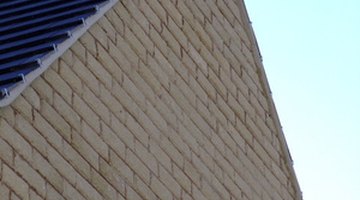How to Connect a Flat Roof to a Gable Roof
Home additions and remodeling often require the extension of a building's footprint. Most existing roofs will not be able to cover the house addition, so a new roof over the extended footprint is usually required. The flat roof is an excellent and economical choice for an addition. The material needs are kept to a minimum, and the flat roof gives a very contemporary look to the newly added space.
Gable roofs are the most common form of roofs. The simple triangular form of the roof affords simple construction and repair. The addition of a flat roof is an excellent choice on any side of a gabled structure as long as the roofs are correctly oriented.

-
Sketch the volumes of the existing and proposed structures. Find where the proposed flat roof will meet the building. If the roof meets the gable above the existing fascia, another roof type may need to be used. However, if the flat roof will meet at or below the fascia, the flat roof is viable.
The problem with the location of the flat roof is the difference in slopes between the two roofs. A flat roof isn't actually flat; it has a slope of 1/4- to 1/2-inch fall every 12 inches. Its appearance is flat, but the slope allows the water to drain from the roof. A gable roof's slope is almost always greater than this, and where the two roofs meet, there is a possibility of water collecting because the draining water would slow from the steep gable to the shallow flat roof. For this reason, a gutter is suggested at the intersection of the two roofs. Otherwise, a roof drain on the flat roof, near the connection, is adequate. Be sure to clear debris from the flat roof's surface.
-
Build the walls of the addition and bolt a 2-by-12 ledger plate to the existing structure at the height of the flat roof. If the ledger plate meets the existing fascia, remove the existing soffit and fascia, and extend the structure of the addition to the wall top plates of the existing building. Another option is to separate the flat roof from the existing fascia, providing a gap to accept a gutter. This will protect against leaks.
-
Place roof joists at 16 inches on center, perpendicular with the existing wall. These joists should not vary in elevation, creating a horizontal plane for the roof. Use joist hangers to fix the joists to the top plates and joist headers of the addition's walls. Screw down plywood to the joists, and cover the assembly with polyethylene sheeting.
The flat roof will slope away from the existing structure, so extend the walls above the rough fascia, perpendicular to the roof slope 4 to 6 inches above the ledger board. This will create a parapet that hides the slight slope of the flat roof.
If a roof drain is to be used, follow the instructions provided with the drain.
-
Place and adhere low-slope rigid foam insulation boards. Be sure the slope is falling away from the existing structure. Cut cant strips, from excess foam, and apply to the intersection of the roof and parapet.
-
Apply the EPDM roof membrane and seal openings with bonding tape. Use flashing at intersections with the walls, drains, and gutters. Apply a coping, if desired. The coping can be metal, stone, or concrete.
-
Place the aggregate on the EPDM as ballast. Level the aggregate, however do not damage the roof membrane when tamping the stone aggregate.
References
- "Residential Framing"; Spence, William; 1993
Resources
Writer Bio
Ryan Crooks is a licensed architect with 15 years experience in residential, institutional, healthcare and commercial design. Crooks is also an instructor, teaching architecture to high school and college students. He has written hundreds of articles for various websites.
Photo Credits
- gable end image by adrian fortune from Fotolia.com
More Articles



